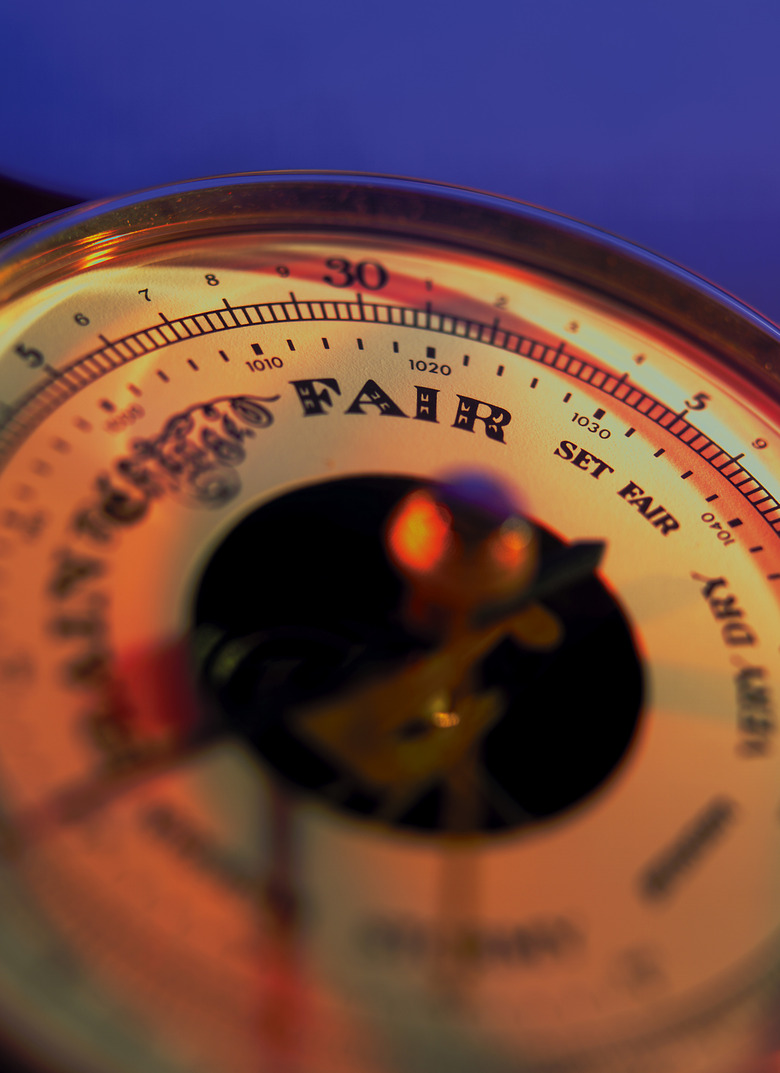Does Barometric Pressure Rise Or Fall When It Rains?
Falling barometers typically predict the approach of worsening weather conditions, while rising barometers point to mild weather. Meteorologists measure changes in air pressure using barometers. High- and low-pressure weather systems move across the country, resulting in changes to barometric pressure. The position of atom and air molecules in the system mark the difference between high- and low-pressure weather systems.
Air Pressure Changes
Air Pressure Changes
Atoms and molecules in the air move constantly, in all directions. This movement creates what meteorologists measure as air pressure. In high-pressure systems, the molecules inside the system move faster than those that surround it. The opposite occurs in low-pressure systems, where the air inside the low is moving more slowly than in the surrounding area. Meteorologists do not define a set pressure for highs or lows. Instead, they define the system by comparing the pressure inside the system to the pressure outside it.
Changing Weather Systems Bring Wind
Changing Weather Systems Bring Wind
Air flows around a high- or low-pressure system in much the same way as water swirls around a bathtub drain. In the Northern Hemisphere, air that moves into a high-pressure system flows outward in a clockwise pattern. Air flowing upward in a region of low pressure moves counterclockwise. This swirling air results in winds around or near the high- and low-pressure boundaries.
Clouds and Weather
Clouds and Weather
Air is more dense in a region of high pressure, so the air pushes out toward less dense regions. The air mass begins to warm as it descends, which retards the formation of clouds. The presence of clouds indicates that rain may be present in the air. High-pressure systems typically have light clouds or no clouds at all, indicating fair weather without rain. In a region of low pressure, the air rises. As it does, the air mass cools and clouds form from the humidity inside the air mass.
Humidity, Moisture, Snow or Ice
Humidity, Moisture, Snow or Ice
Humidity in the rising air of a low-pressure system condenses into water droplets. Once enough moisture collects in the clouds above a low-pressure system, it falls to the ground as precipitation. When temperatures warm, rain is the result. If temperatures are low enough, the resulting precipitation falls as snow. Under certain conditions, particularly when water droplets fall through relatively warmer or colder air masses on the journey to Earth, the low-pressure system may bring sleet or ice.
Exceptions to Every Rule
Exceptions to Every Rule
Rain associated with low-pressure systems holds true in much of the United States most of the time. But more tropical climates – such as those found in the extreme southeastern states – witness fewer and less severe pressure variations unless a tropical storm or hurricanes blows through. Rain association with highs or lows is less predictable in this area of the country, where barometers move more slowly from day to day.
Cite This Article
MLA
Korpella, Robert. "Does Barometric Pressure Rise Or Fall When It Rains?" sciencing.com, https://www.sciencing.com/barometric-pressure-rise-fall-rains-23043/. 9 March 2018.
APA
Korpella, Robert. (2018, March 9). Does Barometric Pressure Rise Or Fall When It Rains?. sciencing.com. Retrieved from https://www.sciencing.com/barometric-pressure-rise-fall-rains-23043/
Chicago
Korpella, Robert. Does Barometric Pressure Rise Or Fall When It Rains? last modified March 24, 2022. https://www.sciencing.com/barometric-pressure-rise-fall-rains-23043/
